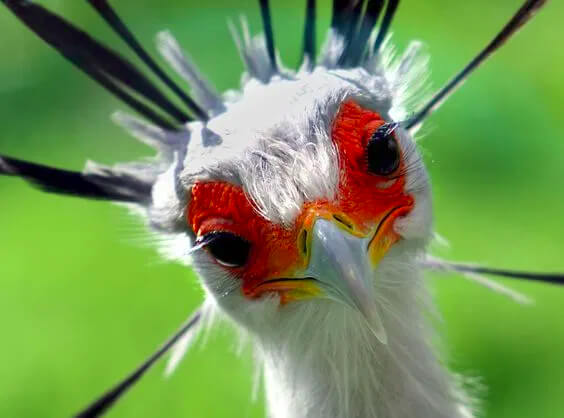It’s no Secretary, it's the Boss!
Review
Sanskruti Biswal and Mukil M

Imagine an eagle, but with the legs of a crane and eyelashes to die for! Confused? This is a short article on the Secretary bird, which unfortunately might disappear from the wilderness even before many have heard of it.
Tweet
The Secretary bird (Sagittarius serpentarius) is a bird of prey found in Africa. It is endemic to the Sub-Saharan African desert, which means this species is exclusively found in this region. Known for its killer looks and signature style of hunting, it is known to stomp its prey to death. Standing tall at close to 1.3 meters, it hunts on foot and kills the prey on the ground. For a bird of this size, it’s extremely light, weighing approximately 4 kgs. Don’t let that fool you though, because its strong legs can generate forces of 200 N, the human equivalent of breaking concrete slabs with bare hands. With a contact time of 15 milliseconds for a kick, this can beat its victim to pulp.
It derives its name from its unique gait and is called “Archer of snakes”; Sagittarius or “Archer” and Serpentarius or “snake bearer”. The common name Secretary is thought to be bestowed because of its resemblance to 19th-century Secretaries who kept quills behind their ears. Often described as “Eagle on stilts,” the Secretary bird has scaly legs and talons that help kill small animals and protect itself from snake-bites. Yes, snakes are its favourite meal! It thrives on a diet of insects, lizards, snakes, and small mammals like mice, mongoose, etc. There have even been reports of it feasting on young gazelles and cheetah cubs. To fish out prey, it stomps its foot on the ground and then kills it by striking blows with its legs with remarkable swiftness. The catch being, the very long legs it uses for stomping also lower its ability to run fast.
 However, all’s not well in paradise. The Secretary bird has been declared as an endangered species by the International Union for Conservation of Nature (IUCN), in the year 2020. A rapid decline in population has been observed lately due to habitat destruction and human encroachment. Timely and thorough ecological studies on the existing population of these birds will be the way forward for deciding on effective conservation efforts.
However, all’s not well in paradise. The Secretary bird has been declared as an endangered species by the International Union for Conservation of Nature (IUCN), in the year 2020. A rapid decline in population has been observed lately due to habitat destruction and human encroachment. Timely and thorough ecological studies on the existing population of these birds will be the way forward for deciding on effective conservation efforts.
Bibliography
Sanskruti Biswal is a 5th-year Biological Sciences major struggling with her master's thesis who tries to dabble in Arts and Science.
Mukil M is a 5th-year Physics major with a passion for painting and wildlife.
signup with your email to get the latest articles instantly